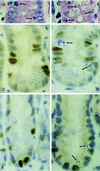Inhibition by uridine but not thymidine of p53-dependent intestinal apoptosis initiated by 5-fluorouracil: evidence for the involvement of RNA perturbation
- PMID: 9050858
- PMCID: PMC19996
- DOI: 10.1073/pnas.94.5.1795
Inhibition by uridine but not thymidine of p53-dependent intestinal apoptosis initiated by 5-fluorouracil: evidence for the involvement of RNA perturbation
Abstract
The epithelia from the crypts of the intestine are exquisitely sensitive to metabolic perturbation and undergo cell death with the classical morphology of apoptosis. Administration of 40 mg/kg 5-fluorouracil (5-FU) to BDF-1 p53+/+ mice resulted in an increase in p53 protein at cell positions in the crypts that were also those subjected to an apoptotic cell death. In p53-/- mice apoptosis was almost completely absent, even after 24 hr. 5-FU is a pyrimidine antimetabolite cytotoxin with multiple mechanisms of action, including inhibition of thymidylate synthase (TS), which gives rise to DNA damage, and incorporation into RNA. The inhibition of TS can be increased by coadministration of folinic acid and can be abrogated by administration of thymidine. The incorporation of 5-FU into RNA is inhibited by administration of uridine. p53-Dependent cell death induced by 5-FU was only inhibited by administration of uridine. Uridine had no effect on the apoptosis initiated by 1 Gy of gamma-radiation. Although thymidine abrogated apoptosis induced by the pure TS inhibitor Tomudex, it had no effect on 5-FU-induced apoptosis, and coadministration of folinic acid did not increase apoptosis. The data show that 5-FU-induced cell death of intestinal epithelial cells is p53-dependent and suggests that changes in RNA metabolism initiate events culminating in the expression of p53.
Figures




References
-
- Lane D P. Nature (London) 1992;358:15–16. - PubMed
-
- Yonish-Rouach E, Resnitzky D, Lotem J, Sachs L, Kimchi A, Oren M. Nature (London) 1991;353:345–347. - PubMed
-
- Potten C S. Cancer Metastasis Rev. 1992;11:179–195. - PubMed
-
- Potten C S. In: Radiation and Gut. Potten C S, Hendry J H, editors. Amsterdam: Elsevier Science; 1995. pp. 1–31.
Publication types
MeSH terms
Substances
LinkOut - more resources
Full Text Sources
Other Literature Sources
Research Materials
Miscellaneous

